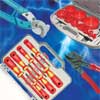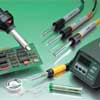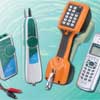Working with electronics as a hobbyist or an engineer can require a large assortment of tools from the basic like a screw driver to the complicated like an oscilloscope. So, what do people working with electronics have in their tool bag? Well, the answer depends on the specific industry they are in. Even screwdrivers have several different sizes and heads which are specific to certain applications. This article will attempt to explain some of the common tools and what they are used for.
Hand Tools
 A basic toolkit should include hand tools like a screwdriver set (Torx, Hex, Phillips, Pozidrive, Slotted, and Square-Head), a small wrench set, a utility knife, insulated tweezers, wire strippers, and a brush. These tools all should be ESD safe, but for some the debate as to whether or not to have a magnetic screwdriver is unending. Although the magnetic field they produce is small, it can do damage, but on the other hand dropping small screws can do damage too.
A basic toolkit should include hand tools like a screwdriver set (Torx, Hex, Phillips, Pozidrive, Slotted, and Square-Head), a small wrench set, a utility knife, insulated tweezers, wire strippers, and a brush. These tools all should be ESD safe, but for some the debate as to whether or not to have a magnetic screwdriver is unending. Although the magnetic field they produce is small, it can do damage, but on the other hand dropping small screws can do damage too.
Basic Soldering Kit
 Soldering irons come in various shapes and sizes. What you need depends on your application. A simple $15 or $20 iron can attach wires and slightly more expensive cordless soldering pens/irons are available, but if you normally sit at workbench soldering everything from wire to PCB’s, a temperature controlled soldering station with adjustable wattage and a range of tips that is ESD safe is more suitable. Butane soldering irons are great for portable applications. Hakko and Xytronic both have a wide range of soldering irons and stations.
Soldering irons come in various shapes and sizes. What you need depends on your application. A simple $15 or $20 iron can attach wires and slightly more expensive cordless soldering pens/irons are available, but if you normally sit at workbench soldering everything from wire to PCB’s, a temperature controlled soldering station with adjustable wattage and a range of tips that is ESD safe is more suitable. Butane soldering irons are great for portable applications. Hakko and Xytronic both have a wide range of soldering irons and stations.
Soldering wire is as wide ranging as solder equipment. For general purpose applications, 60/40 Tin/Lead wire is commonly used, but for lead free applications 95/5 tin/antimony wire is common. The lead free solder has a higher melting point, so care must be taken with sensitive equipment.
Desoldering tools are also a must. A desoldering iron both heats solder and removes it through suction. A desoldering iron is a combination of a soldering iron and a desoldering pump.
Meters and Testers
 Digital Multimeters
Digital Multimeters
A digital multimeter is essential for an electronics enthusiast. A multimeter is a device that can measure voltage, current, and resistance. They can be used to troubleshoot electrical problems in a wide array of industrial and household devices such as batteries, motor controls, appliances, power supplies, and wiring systems. A fancy expensive multimeter is not needed, at least not while you are just starting out.
Make sure you have a good well insulated set of test probes. This is for your own safety as you may be measuring relatively high voltages. Periodically inspect for damage and repair or replace as needed. If the ones that came with your multimeter are substandard - flimsy connectors or very thin insulation, replace them as well.
Oscilloscopes
The oscilloscope is one of the most versatile and widely-used electronic instruments. A typical oscilloscope has a display screen, numerous input connectors, and control knobs and buttons on the front panel. Portable instruments are small enough to carry to a work site and may even be battery operated. The signal to be measured is fed to one of the input connectors, which is usually a coaxial connector such as a BNC or UHF type. Binding posts or banana plugs may be used for lower frequencies. If the signal source has its own coaxial connector, then a simple coaxial cable is used; otherwise, a specialized cable called a "scope probe", supplied with the oscilloscope, is used.
Probes
Probes with 10:1 attenuation are by far the most common; for large signals (and slightly-less capacitive loading), 100:1 probes are not rare. There are also probes that contain switches to select 10:1 or direct (1:1) ratios, but one must be aware that the 1:1 setting has significant capacitance (tens of pF) at the probe tip, because the whole cable's capacitance is now directly connected.
Power Supplies
Adjustable linear power supplies are common laboratory and service shop test equipment, allowing the output voltage to be set over a wide range. For example, a bench power supply used by circuit designers may be adjustable up to 30 volts and up to 5 amperes output. Some can be driven by an external signal, for example, for applications requiring a pulsed output.
Programmable power supplies can furnish DC, AC, or both types of output. The AC output can be either single-phase or three-phase. Single-phase is generally used for low-voltage, while three-phase is more common for high-voltage power supplies.
When choosing a programmable power supply, several specifications should be considered. For AC supplies, output voltage, voltage accuracy, output frequency, and output current are important attributes. For DC supplies, output voltage, voltage accuracy, current, and power are important characteristics. Many special features are also available, including computer interface, overcurrent protection, overvoltage protection, short circuit protection, and temperature compensation. Programmable power supplies also come in a variety of forms. Some of those are modular, board-mounted, wall-mounted, floor-mounted or bench top.
More Tools
Wave Solder Machine
The tools above are commonly found in an electronics toolkit, but manufacturing electronics requires more tools. Wave solder machines, for example, are used for large scale soldering. A tank holds a quantity of molten solder; the components are inserted into or placed on the PCB, and the loaded PCB is passed across a pumped wave or waterfall of solder. The solder wets the exposed metallic areas of the board (those not protected with solder mask, a protective coating that prevents the solder from bridging between connections), creating a reliable mechanical and electrical connection.
Beyond the scope of this article are even more tools for voice/date like pulse testers, continuity testers, and many more.
Sources:
http://en.wikipedia.org/wiki/Oscilloscope
http://en.wikipedia.org/wiki/Power_supply
http://en.wikipedia.org/wiki/Wave_soldering
http://www.hakkousa.com
http://www.repairfaq.org/sam/tshoot.htm#tshtes